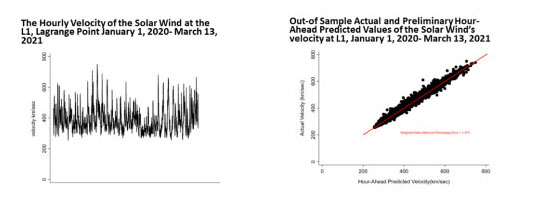A Methodology to Predict the Geomagnetic Field and the Velocity of the Solar Wind
Kevin F. Forbes
Founder, Energy and Environmental Data Science
Malahide, Ireland
The Catholic University of America (retired)
 It is well established that solar activity can give rise to geomagnetic storms harmful to
It is well established that solar activity can give rise to geomagnetic storms harmful to
communications, Global Navigation Satellite Systems, and electric power systems. Unfortunately, while significant progress has been made in understanding the nature of the challenge, it is recognized that there is room for improvement in prediction. This paper presents a machine learning time-series approach that may ameliorate matters. Specifically, a methodology is presented to predict the geomagnetic field at the Earth’s surface and the velocity of the solar wind in space at an hourly resolution. The modeling approach employed in this paper is distinct from other forms of machine learning because it presumes that the data has a time-based dimension. At its core, it presumes that past events influence the current outcome. The approach also enables modeling the volatility of a data series over time. The model presented here is an autoregressive conditional heteroskedasticity/autoregressive–moving-average model (hereafter, an ARCH/ARMA model). The method was developed in the field of econometrics. It has since proven invaluable in modeling any time-series variable that is autoregressive in which there are also periods of turbulence followed by a relative calm at some point. Both the geomagnetic field at the Earth’s surface and the velocity of the solar wind coming from the Sun have these properties.

Refreshments served at 3:45 PM
If you have any questions about the Colloquium Series or would like to make a donation please contact the Physics Department, cua-physics@cua.edu or (202) 319-5315.
